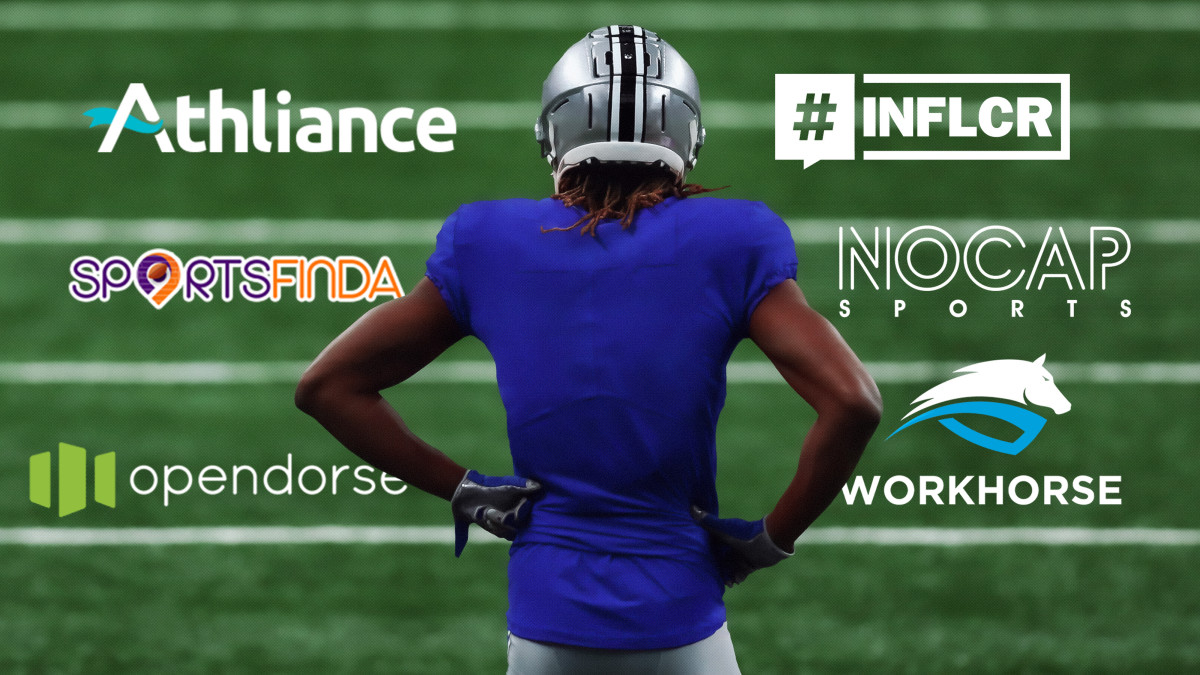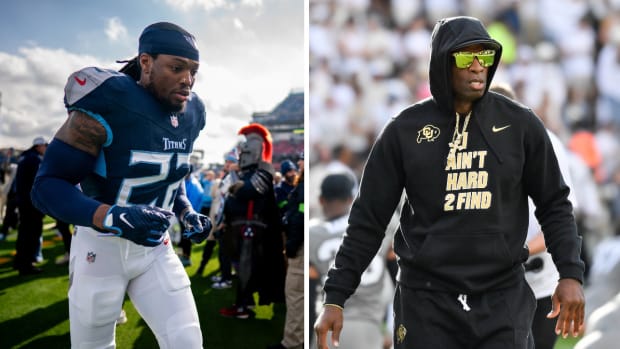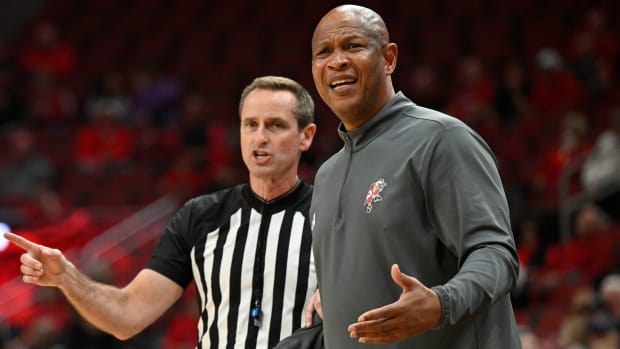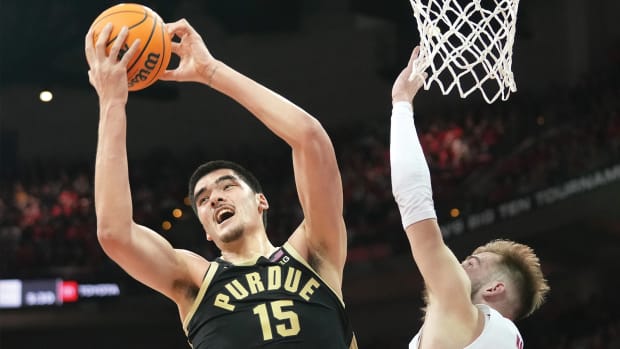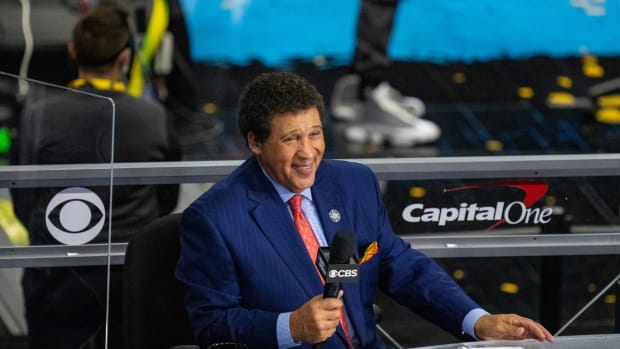Inside the Hidden Industry of Name, Image and Likeness and the Changing World for College Athletes
For two years now, Icon Source has provided a marketplace for talent, such as pro athletes and social media influencers, to connect with brand companies for endorsement and commercial opportunities. Like a match-making service that pairs like-minded couples in romantic relationships, Icon Source links talent with brands in business arrangements.
Last Thursday, the marketplace added a new player.
College athletes became eligible to create profiles on Icon Source in what is, for the company, the first step in helping NCAA athletes monetize their name, image and likeness (NIL). Eventually, an athlete on Icon Source will be able to identify companies to partner with for a profitable exchange.
Maybe it’s a star quarterback hooking up with an eatery in Athens, Ga., or a champion gymnast signing with a clothing shop in Oxford, Miss.
Either way, the world of NIL match-making is here—well, almost.
It officially arrives in about 70 days, when several state laws governing NIL take effect.
“Athletes are preparing themselves for July 1,” says Drew Butler, a former NCAA and NFL punter who is vice president of Icon Source’s collegiate division. “We are ready to turn on the green light for them.”
So are dozens of others.
The introduction of NIL to the college scene has created a striking side effect: a cascade of activity in an untapped space. As July 1 nears, companies similar to Icon Source are bursting onto the scene, offering an array of NIL-centric products and services to schools and athletes alike.
As many as 150 NIL platforms now exist in what has become an oversaturated space exploding with outlets flaunting new-fangled databases and glitzy mobile applications. They are all different and yet, for many of them, very much the same.
Some are specializing in NIL education, marketing and branding. Others are focused on compliance and regulatory issues. Another group is targeting the marketplace, where athletes connect with brands. And some companies are even dabbling in all three.
A few, in fact, are dangerously walking the line, industry experts say, of violating potential legislation by partnering with schools while also offering athletes at those schools a marketplace to strike NIL deals.
In short, this space—empty and quiet just months ago—is now a crowded, muddled and boisterous mess.
“It’s the hidden industry of NIL,” says Blake Lawrence, a former Nebraska linebacker and the co-founder of Opendorse, one of the largest and longest-tenured athlete marketing platforms in the country.
These NIL companies are jockeying to land lucrative school partnerships and are one-upping each other to attract college athletes. For institutions, these platforms serve as both an oversight and regulatory system, educating their athletes on NIL and tracking their NIL endeavors for compliance purposes. For athletes, they represent much of what a sports agent or an agency does: help build a brand (on social media, specifically), market that brand and arrange for NIL events.
Most in college sports believe that the vast majority of athletes will gross too little to hire an agency, leaving them instead with a digital marketplace, where athlete subscriptions are often free (the marketplace normally takes a transaction fee, 10%–15%, from the brand company).
There are plenty to choose from.
There are those providing a service, such as companies like Altius, which almost exclusively partners with schools as an educational and compliance component. There are those that provide a product, such as MatchPoint Connection, which offers a match-making marketplace. And there are those providing both a service and a product, such as Opendorse, which features compliance, education and marketing components as well as a separate marketplace called Opendorse Deals.
Sports Illustrated obtained a list of more than 100 NIL platforms of varying specifications. There’s one called Inked Sports and another called Workhorse. PlayBooked and Athletes Studio. Greenfly and INFLCR.
The more well-known agencies and media rights groups, like CAA, Wasserman and Learfield IMG, count too.
There’s Athliance and Gridline, as well. Momentum and SAIL. GamePlan, Calaxy and Dreamfield.
“Last year, it was crickets,” says Ahmad Elhawli, the founder and CEO of Sportsfinda, a somewhat unique platform that offers athletes opportunities to sell their equipment or gear, auction any other valuables and generate dollars through fundraising campaigns. “January hit this year and companies started popping up. We were ready for the big [NCAA NIL] vote in January but that never took up.”
Set to pass NIL at its virtual convention in mid-January, the NCAA delayed the decision, citing a letter from the Department of Justice. However, a more practical reason has emerged. The governing body of college athletics is waiting for the Supreme Court to rule on its antitrust case, NCAA v. Alston, before passing any NIL legislation, multiple sources tell Sports Illustrated. Some contend that approving NIL would damage the NCAA’s argument in Alston, weakening its chances for a victory in a case that, while it centers around antitrust, also could produce a decision that greatly impacts amateurism.
But how long is the NCAA willing to wait? The Alston decision isn’t expected until June, if not later, coming dangerously close to what is becoming a D-Day for college sports: July 1. Eleven states have passed NIL laws, four of which take effect July 1: Mississippi, Florida, New Mexico and Alabama. Two more states have a bill awaiting a governor’s signature to become law and 18 more have introduced a bill this spring, as states hurry to one-up one another for recruiting purposes.
“It’s going to be a little chaotic for a time,” says Oliver Luck, a former college administrator and NCAA executive. “The next three or four months, it’s the most uncertain time in the history of college athletics.”
Big 12 commissioner Bob Bowlsby, part of the NCAA’s NIL working group, says the group has met at least twice a month, spending the last four months continuously tinkering with what they term as an evolving NIL legislative proposal. SI obtained the original proposal last fall.
While the NCAA hopes Congress passes a federal bill to govern NIL, the organization expects at some point to remove its tabled item and pass the long-awaited measure.
“There are those advocating to pass it before July 1,” Bowlsby says. “There are those who say some of the chaos is required and let the state laws go into effect. It puts the institutions in a tough spot. They’re going to either comply with NCAA rules and against the state or comply with state law and against the NCAA.”
Most plan for the latter. And they’re not wasting time.
In fact, in one of the most recent announcements last week, Florida State revealed a new partnership with INFLCR, a multi-faceted NIL platform that will provide the department compliance oversight and will educate athletes as well as build their brands.
The three-year deal will cost FSU $102,000, says Jim Curry, a senior associate athletic director who helped orchestrate the agreement. INFLCR gives FSU athletes the tools to develop their brand and complete NIL deals, but it doesn’t mean they have to use the company. Other vendors are available to which athletes can independently subscribe.
While the INFLCR arrangement should help unburden some of FSU’s compliance staff, the department still plans to hire extra compliance officers to handle NIL tracking and oversight, Curry says. Many schools are planning the same.
The process of choosing INFLCR was made difficult as FSU officials had to “cut through all the clutter” in the marketspace, Curry says. “There are a lot of vendors in the space and new people coming into the space. And then you top that with a complete lack of clarity at the NCAA, state and federal levels.”
The NIL platform companies aren’t waiting around for the NCAA, either.
Altius founding partner and CEO Casey Schwab, an ex–NFL Players Association executive, recently returned from a trip to meet with coaches and administrators at South Carolina, one of his new clients. The Gamecocks joined LSU and Texas in hiring Altius, which works with schools strictly to provide compliance and educational services.
“It’s the less sexy side,” laughs Schwab.
The company has no plans to dabble in the marketplace of matching athletes with businesses. It’s too risky, he says.
Those familiar with the NCAA’s evolving NIL legislative proposal say schools, or third parties hired by schools, won’t be permitted to secure NIL opportunities for athletes. That includes “pairing a student athlete with a company seeking a student athlete for an advertisement,” according to a question-and-answer document the NCAA distributed to schools in December.
Similar language is used in most state laws, says Jim Cavale, the CEO of INFLCR.
“We believe legislation is clear that you can’t be the marketplace and work with institutions who are paying you,” he says.
To Cavale, there are three cookie jars: the institution, the athlete and the marketplace.
“You’ve got to be careful if you’re trying to put your hand in all three cookie jars,” he says. “You can get in trouble.”
However, there are ways around this and even his own company has found them. Next week, INFLCR is scheduled to announce a new product that offers a space for brands and athletes to connect. Athletes can then leave INFLCR—an important and necessary step to remain compliant—to strike a deal with a company on the brand’s own platform.
Opendorse, meanwhile, offers a separate marketplace called Opendorse Deals. Opendorse is used by more than half of the Power 5 programs, so in order to remain compliant, an athlete must leave Opendorse’s regular educational and brand-building platform to strike deals independently with brands on Opendorse Deals, which schools are not a part of.
While Opendorse’s other functions rely on lucrative school partnerships, Opendorse Deals takes a transaction fee from brands.
“Every school I’ve spoken to is very worried about a marketplace,” says Lyle Adams, the CEO of Spry, which provides NIL regulatory services to schools and does not offer a marketplace. “The NIL legislation says schools cannot offer athletes deal-matching solutions or pay for them. That would be considered institution involvement.”
“I’m not going to say anything negative about anybody else in this space,” says Schwab, of Altius. “Everybody has their own speciality, but when the rules are finalized, everybody from the schools to the athletes are going to figure out who is doing what and what companies are on their side.”
Florida State’s deal with INFLCR comes with options, says FSU AD David Coburn. The university can later incorporate into its deal INFLCR’s newest marketplace product, the one set for an announcement next week, if legislation permits such.
“What we tried to do is pick a platform that allowed us to pay for and use some elements that we’re comfortable we can use now and reserve the option to buy other elements in the future should they become permissible,” he says.
Coburn, who spent decades serving in Florida politics before entering higher education, says the Seminoles will, first and foremost, follow the state’s NIL law, even if it contradicts the NCAA’s own NIL legislation. There is a financial incentive to do so. Institutions that do not follow the Florida law are in jeopardy of losing state funding, according to the law itself.
Florida is set to be one of the first states to enact its NIL law. Whatever advantage the Seminoles are getting in recruiting “might be offset by the threat of NCAA sanctions,” Coburn says. “Am I concerned? Somewhat, yes, but do I know what my obligation is under state law? Yes.”
The uncertainty around legislation is clouding an already murky situation as athletic administrators across the country search for an NIL platform. Some are basing decisions around their own state law. Others are focused on the NCAA’s proposed legislation, the latest version of which has not been revealed to them.
In many cases, the NCAA’s own proposal policy is not as open and athlete-friendly as the state laws.
“Anyone who thinks they’re with a company that has figured it out is full of malarkey,” says one athletic director. “There are too many unresolved questions.”
For the most part, there are three glaring questions that, from a practical business standpoint, will determine just how many opportunities exist under the new framework of NIL rules, Schwab says.
(1) Can the athletes strike NIL deals with corporate partners of the schools? (2) Can the athletes strike NIL deals with competitors of corporate partners of the schools? And (3) can the athlete use the school’s marks and logos during endorsement ventures? No. 3, for now, is strictly prohibited in the NCAA’s proposal, and No. 2 is left up to the school. No. 1 is tricky.
“The rules need to make both business and legal sense. Business, so that there are legitimate opportunities for the student-athletes. And legal, because if those opportunities are overly restricted, there will be lawsuits,” Schwab says. “If there’s one thing we know on this topic, there will be lawyers.”
Meanwhile, of the 150 or so NIL platforms existing in the space, one of them is expected to be chosen as the NCAA’s third-party administrator (TPA), acting as a sort of clearinghouse for NIL. However, like NIL legislation itself, the NCAA has delayed selecting a TPA, despite whittling a list of candidates to four finalists late last fall.
The finalists include Opendorse, Salesforce, CLC and INFLCR, sources told SI. The NCAA Division I Council discussed a TPA during its latest meeting last week but did not take a vote. It’s unclear when that will happen, but some are growing frustrated as July 1 nears. With each passing day, the TPA has less and less time to prepare to service the entire NCAA once the organization passes NIL.
It’s one of the many unresolved issues in what’s become a convoluted space.
“There are still a lot of unknowns,” says Henry Hays, the founder of MatchPoint Connection, a Baton Rouge–based NIL marketplace that is about three weeks old. “But if you’re a state and you don’t have a [state NIL law], you’re dead in the water. How do you recruit?”
For now, those in four states can soon begin striking deals with businesses on July 1. By the time that date arrives, that number could reach double digits, as several states are hurriedly pushing through bills, two of which need only a governor’s signature to become law.
The day of NIL match-making, at least for some, will soon arrive. The hard part now: picking your match-making company.
“There are a lot of hustlers out there,” says one associate athletic director. “Everybody is doing what they think is best to cash in on the student-athletes. These are businesses cashing in on the student athletes. I don’t blame them. They sit in front of you and tell you what’s best for the student athletes. But nobody knows what this marketplace is going to look like.”
More College Sports Coverage:
• The NCAA Transfer Revolution Is Here
• The Shining Disparities Between Men's, Women's CBB
• What Would a CFB Super League Look Like?
